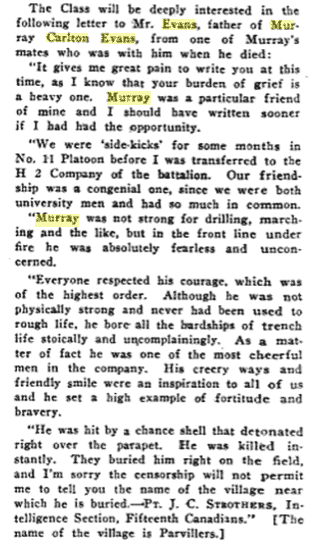Murray was an American who enlisted with the Canadian Expeditionary Force, and a good friend of John Cannon Stothers (JCS) working together in the Intelligence/Scout Unit
He was born on August 7th, 1893 and his occupation is listed as a student on attestation. Apparently a good one as well, appearing on Princeton University’s Roll of Honour, however… more on this later.
At 23 years of age, Murray joined the 241st Battalion, C Company, at Windsor Ontario on March 29th, 1917.
The 241st Battalion left in late April from Halifax to Liverpool on the SS Olympic. Upon arrival on May 7th, they proceeded to West Sandling Camp and were absorbed into the 5th Reserve Battalion,
On October 11th he joined the 15th Battalion at Avion and was assigned to C Company. He suffered an accidental injury to his left heel on November 17th, and reported to 1st Field Ambulance, transferring to 12th Field Ambulance. He returned to duty and rejoined the15th Battalion at Gouy Servins in December.
John Cannon Stothers notes his relationship with Murray in a letter to home, dated January 12th, 1918:
“I’m getting to old to write. My sidekick from St. Louis has just received a parcel containing two suits of reindeer skin underwear. It costs $17 a suit and is supposed to be louse proof. He offered me one of them but I haven’t the heart to rob him at all, at all. He is a mighty good scout, none to prepossessing in appearance, but he travelled in high society in St. Louis, talking glibly but in his peculiar Southern drawling style, of debutantes, second year outs, my Club, his favorite type of car, and all things in life pertaining to the “Upper Ten”. He was prevented from graduating in his fourth year at Princeton by getting mixed up in some escapade.
His name is Evans, and he is not a smart looking soldier, but is different from, and more intellectual than most. During his second trip in the line, he accompanied an NCO on a dangerous mission when few would volunteer for the duty, and for which the NCO has frequently been mentioned as a deserving recipient for Military Medal. Instead of getting the MM, the NCO got a “blighty” and is now in England in Hospital.”
On January 30th, 1918, he was attached to 3rd Australian Tunnelling Company rejoining the 15th Battalion at Fosse 10, Lens very briefly in February. He was then back with the 3rd Australian Tunnelling Company later in February, returning again to the 15th Battalion in early March.
On August 17th, 1918, at the later stages of the Battle of Amiens, Murray was killed in a front line trench at Parvillers by a high explosive shell. He is buried at Bouchoir New British Cemetery and is commemorated in the First World War Book of Remembrance, pg. 405.
From the regimental history book, 48th Highlanders of Canada, 1891-1928, Kim Beattie, p.340.
“They spent the night and the next six days astride the Parvillers – Le Quesnoy Road with their Battalion H.Q. in a dugout, 300 yards south-east of the road. The Battalion transport during this period was putting in a bad time in Beaufort Orchard, which was shelled steadily. Brigade H.Q. on the night of the 15th got them out of it by moving them back to Hospital Valley. They had much further to travel with rations but there was at least peace until the moon came up, when they were again bombed mercilessly. The tour was uneventful, except for constant shelling of Parvillers, which killed 6 men and wounded 15*, and a gas deluge which sent 8 men out of the line coughing and nauseated. It was apparent now to all ranks that the Battle of Amiens was history.”
John Cannon Stothers underlined this portion of the above sentence in his personal copy of this regimental history book and wrote M. Evans on the side panel of page 340.
John Cannon Stothers followed up with a letter to Murrays’ parents in 1918 (Attached. Credit: Find A Grave, Tom Nichols, Baltimore).
NOK: H.H. Evans (F) 5237 Washington St., St Louis, Mo, USA


